IBOGAINE, the one drug which can actually reverse Parkinson’s is a Schedule I drug in the United States. At low doses, 20 mg per day, it can across actually reverse Parkinson’s, it can heal opioid and other addictions, and can heal OCD and other compulsive behaviors. However, in the United States it’s a Schedule I drug, which means, not only can’t patients get IBOGAINE treatment, it can’t be researched legally in the United States. Schedule I drugs are very difficult to research because the US government has deemed them to have no medical value, which simply isn’t true.
https://www.ibogainealliance.org/ibogaine/therapy/parkinsons/
https://psilocybintechnology.com/johns-hopkins-scientists-recommend-rescheduling-psilocybin/
https://psilocybintechnology.com/tim-ferriss-and-psychedelics/
https://psychedelictimes.com/2015/08/13/iboga-culture-learn-how-this-psychedelic-plant-became-a-national-treasure-and-therapeutic-trend/
Ibogaine treatment is available in both Canada and Mexico. The problem is that, because people usually can’t take time away from work or life, it’s often not the best option. At low doses, 20mg per day, Ibogaine is very effective but when you have to leave the United States and seek treatment elsewhere, Ibogaine generally has to be given in high doses, doses which can be cardiotoxic. This shouldn’t be the case if it were available in the United States but the United States has made it nearly impossible for people who could be free of life with Parkinson’s disease to get treatment in the US.
Ibogaine also cures opioid addiction. No need for the use of other opioids, which is so counterintuitive to curing opioid addiction… and other addictions as well.
https://www.ibogainealliance.org/news/feeding-the-hungry-ghosts-ibogaine-in-the-psychospiritual-treatment-of-addiction/
https://www.ibogainealliance.org/news/could-ibogaine-be-a-promising-new-treatment-for-parkinsons-disease/
How can this be? In a nation which is purported to be one of the most educated, progressive, and supposedly has some of the best healthcare in the world. Well, there’s the problem, we don’t offer the best healthcare in the world. The war on drugs, United States drug policy have created more problems worldwide than most people know. We think our government is fighting the good fight in the war on drugs. Most of the world has abandoned US drug policies because it’s done far more harm than good. It’s destroyed societies, lives, and families. The war on drugs has been great for policy-makers, lobbyists, special interest groups, DATA 2000 addiction doctors, and even pharmaceutical companies. How? Who do you think is making the opioids that are given to opioid addicts? The very same pharmaceutical companies the United States government is continually suing, using our tax dollars! It’s a complete perversion of our system.
Labs doing drug testing charge up to $5,000 for a comprehensive drug test – for those with insurance. Those without insurance usually can’t get treatment Imagine how profitable that is for the labs and doctors who are receiving kickbacks from the labs to whom they refer their patients. If one clinic is treating 100 patients, at $5,000 per test done quarterly, that’s an incredible profit for both the lab and the doctor.
It’s not only addicts who are being drug tested, add all the chronic pain patients being regularly tested, despite the fact that chronic pain patients have the lowest rate of addiction and abuse of any patient population. Millions of people being tested, sometimes monthly depending on the physician. That’s a great deal of profit and an even greater amount of corruption. Of course, not all pain management doctors are corrupt. More often than not, they genuinely want to help their patients struggling with intractable chronic pain. Unfortunately, again, it’s US drug policy, the CDC “guidelines”, and the DEA targeting those who don’t deserve to be targeted. More and more doctors are being abused by the system, jailed, and losing everything because those doctors who dare to treat chronic pain patients are innundated with the patients no one else will treat with life-restoring opioid pain medication.
Another problem is the faulty reporting by the CDC. It used to be that doctors could write one prescription for opioid pain medication with 2 refills. This counted as one prescription. Now, doctors can write one prescription each month and each is an individual prescription. However, the CDC and DEA report that prescriptions written for opioid pain medications have increased. Obviously, this is not the case.
Back to Ibogaine… It can not only treat and reverse Parkinson’s disease, it can successfully treat opioid addiction, as well as OCD and other compulsive behaviors.
https://podcastnotes.org/2018/09/22/morris-2/
https://thedrugclassroom.com/video/ibogaine-iboga/
Before dismissing psychedelics, please consider that they are being used in PTSD, various mental health issues like depression, and end of life treatment… All very effectively. Again, these are Schedule I drugs, previously thought to have no medical value in the United States. It’s very unfortunate.
https://psychedelictimes.com/learn-more-iboga/
https://psychedelictimes.com/2017/05/31/death-and-family-healing-with-psilocybin-a-conversation-with-dennis-mckenna/
My absolute favorite quote from the TV series, “The Crown”, is:
“This is not a government. This is a collection of hesitant, frightened, old men unable to unseat a tyrannical, delusional, even older one.” Seems apt, however, this wasn’t said about the US government, it was said about Winston Churchill and his government.
In my opinion, corruption is a big problem when it comes to our government but another big problem is that we simply have policy-makers who are often too old, very uneducated regarding drugs and drug policy, and fearful – subject to juvenile peer pressure. It’s just not serving the people of the United States in any way. As most of the world moves forward with better drug policies, the United States will continue to fall behind unless we insist they explore decriminalization, regulation, and harm reduction.
http://www.drcarlhart.com
http://www.hamiltonmorris.com

 Bill McRaven, who recently retired as a four-star admiral after 37 years as a Navy SEAL, became Chancellor of The University of Texas System in January 2015.
Bill McRaven, who recently retired as a four-star admiral after 37 years as a Navy SEAL, became Chancellor of The University of Texas System in January 2015.

